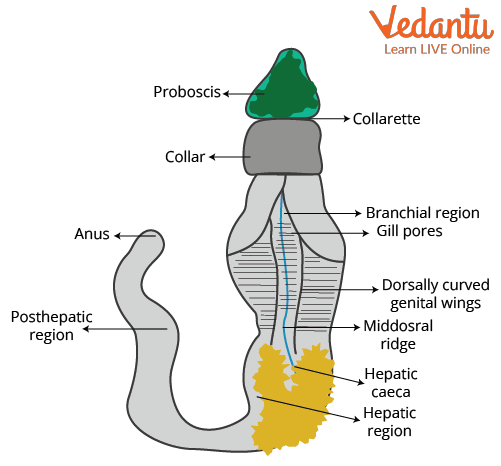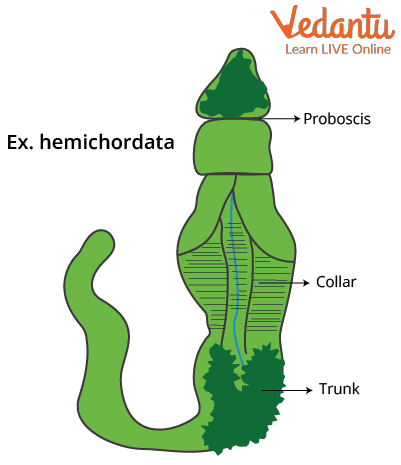




What is Hemichordata?
Hemichordata is a phylum in the animal kingdom that has only a few hundred species. This topic is very important for your Boards as well as NEET preparation. This article will give you a quick revision of this topic before you appear for any of these exams. The topics related to Animal Kingdom have to be understood properly so that you do not get confused at the end moment.
In this article, you will be able to cover all the sub-topics that come under the Phylum Hemichordata such as characteristics, classification, examples, development, and so on.
Important Concepts of Chapter Hemichordata
Hemichordates is a phylum in the animal kingdom.
It consists of invertebrate animals.
Some of the examples of Hemichordate include Balanoglossus and Saccoglossus.
The phylum hemichordates comprise a group of wormlike marine invertebrates closely related to chordates and echinoderms. They are commonly classified as a phylum, the Hemichordata. The term ‘Hemichordata’, coined after the buccal diverticulum, was shown to be half-chordate (from the Greek hemi, meaning "half," and chorde, meaning "string"). The existence of a stomochord is one of the Hemichordata’s most distinguishing features.
They live on the seafloor and are usually found in oceans. They range in size from a few millimetres to about one and a half metres in length. Balanoglossus gigas is a hemichordate that can grow up to 1.5 metres long. These creatures eat tiny organic particles. Filter feeders or substrate eaters are also possible.
Basic Characteristics of Hemichordata
Hemichordates can be considered advanced invertebrates because of their close relations with chordates and echinoderms. The following are the hemichordata characteristics:
Hemichordates are primarily non-vertebrates; a vertebral column does not replace notochord in the embryonic stage.
They are exclusively marine invertebrates.
They are eucoelomate, possessing a true body cavity that is originally derived from a germ layer called mesoderm during the embryonic stage.
Their body exhibits a bilateral symmetry (divisible in two symmetrical halves) and they are triploblastic animals (presence of 3 germinal layers; outer ectoderm, middle mesoderm and inner endoderm).
They are also enterocoelous, a kind of true coelom which is formed by pinching off from the digestive tract.
Their respiration is from gills.
Anterior proboscis, middle collar and posterior trunk are the three parts of their body.
A single-layered epidermis is present outside the body wall with several mucous glands.
The dermis is absent.
The buccal diverticulum, earlier known as the notochord, is present in the anterior end of proboscis. Notochord found in the anterior end is usually called the stomochord.
The alimentary canal is a straight or U-shaped tube.
One to many pairs of pharyngeal gill slits are found.
These are filter feeders, which use a kind of aquatic feeding, in which the food particles are strained from the suspended matter by proboscis.
Their circulatory system is of simple and open type, owing to a dorsal heart and two longitudinal veins, one dorsal and one ventral.
Their primitive nervous system is mostly made up of the subepidermal nerve plexus, consisting of sensory cells, ganglion cells. Their related nerve fibres are usually located in the lower mesenchyme tissue of the body.
The dorsal nerve cord extending through the collar region is hollow.
The excretion is through a single glomerulus located in the proboscis.
Reproduction is mainly of sexual type. Sexes can be separate or within the same organism (united).
The reproductive system consists of one to numerous pairs of gonads.
The type of fertilisation is external; that is, the fertilisation of the egg occurs outside the body of the female by a male sperm.
Larvae is a free swimming one, known as tornaria.

A Hemichordata Diagram Depicting The Body Organization of a Hemichordate Animal
Let us Take a Glance at Their Characteristics:
Development of Hemichordates
They primarily follow deuterostome mode of development, which is found in both Chordata and Echinodermata, that is, the mouth is formed in the second opening other than the blastopore (the first opening is formed in the embryo). The second opening usually forms an anus in the higher chordates. The developmental stage can be direct or indirect. The major difference is that the indirect stage involves a free-swimming larval growth form; while in the direct mode, the organism develops directly into an adult without any intermediate stages. The cleavage of the embryo is usually of radial (identical pieces are generated when cut through axis) type.
Classification of Hemichordata
The phylum hemichordata is divided into two classes:
Enteropneusta (Acorn worms) and Pterobranchia. There is also an extinct class of Hemichordata, named Graptolites. These are closely related to the Pterobranchia and can be studied through fossil records.
Enteropneusta is solitary, wormlike, bilaterally symmetrical, brightly coloured invertebrates. Because of the shape of the proboscis and collar, they are called acorn worms. They are slow burrowers who use their proboscis to burrow through sediment. They can deposit feed (consume sediment and digest organic substances, similar to earthworms in soil) or suspension feed (collect suspended particles from the water). Some of these worms can grow to be quite enormous; one species can grow up to 2.5 metres long (almost eight feet), while most are much smaller.
Pterobranchia develops colonies with stems, or stolons, that connect them. Individuals, known as zooids, are typically less than one millimetre long. The proboscis is shield-shaped rather than extended, as in acorn worms.
Examples of Hemichordata
Some of the hemichordata examples include:
Balanoglossus
Saccoglossus
Rhabdopleura
Atubaria
Dendrograptus

Balanoglossus, an Example of Hemichordata
Conclusion
The article above gives an insight into a phylum of the animal kingdom called Hemichordates and discusses all of its characteristics as per the syllabus. The most important topics covered are the features of hemichordates and their examples. The questions provided above are examples of the types of questions you can get in your examination.
FAQs on Hemichordata - NEET Important Topic
1. How many questions can you expect from Hemichordata in the NEET examination?
There has been a question from the Hemichordates topic once every two years. The questions are basic, so make sure to remember the basic concepts on your tips. These include the characteristics of invertebrates and the examples of Hemichordates. The most basic and reliable approach to learn these phylums is to draw tables, mind maps, sticky notes and mnemonics. A student must make notes in such a way that they can revise them within a few minutes and do multiple revisions before the exam.
2. Is it important to cover the chapter Animal Kingdom to get through NEET?
Yes, it is very important to cover Animal Kingdom in order to qualify for NEET with a good score. This chapter holds up to 10% weightage from biology in the NEET exam. To prepare for the NEET examination, make sure to cover the phylum Coelenterata, Arthropoda, and Annelida thoroughly. You can prepare all the other phyla by studying only the basic characteristics and a few examples. A student should make separate characteristics notes of each phylum, larval names, and so on. This chapter requires multiple revisions of NCERT and lots of question practice.
























